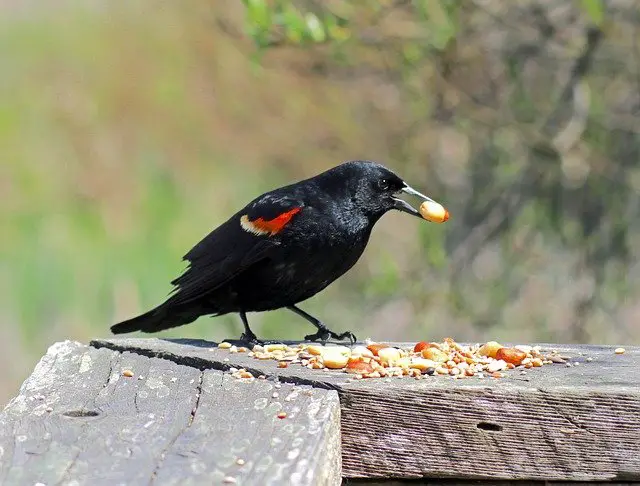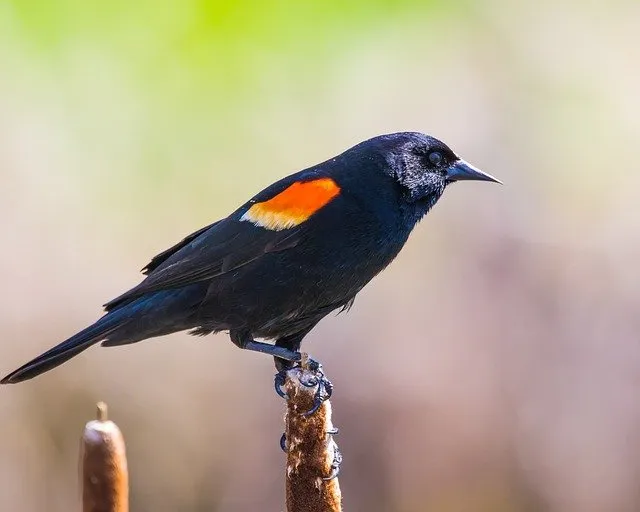As an Amazon Associate I earn from qualifying purchases.
In nature, the red-winged blackbird is a captivating sight, with its presence standing out among the sky and the world filled with life. With its glossy black plumage adorned by vibrant scarlet and yellow epaulets, this winged troubadour of marshlands and meadows casts a spell on all who can witness its graceful flight. But beneath its striking appearance lies a fascinating secret—the red-winged blackbird’s culinary prowess. So what do red winged blackbirds eat?
In exploring the blackbird’s gastronomic journey, we delve into a captivating gastronomy and ecological significance tale, unveiling the diverse palette that fuels this avian virtuoso in its quest for survival amidst the changing seasons and the ever-rolling cycles of life. From insects to fruits and everything in between, embark with us on a thrilling gastronomic expedition into the world of the red-winged blackbird.
What Do Red Winged Blackbirds Eat?
Nestled amongst the reeds and cattails of marshes, lakeshores, and wetlands, the red-winged blackbird (Agelaius phoeniceus) is a captivating symbol of the avian world. With its vibrant red and yellow shoulder patches, melodious song, and charismatic demeanor, this iconic songbird is a delight for birdwatchers and nature enthusiasts alike. However, beyond its striking appearance and harmonious vocalizations lies an intriguing aspect of its life: its diet. In this blog post, we will explore the diverse range of foods red-winged blackbirds consume, shedding light on their ecological importance and the delicate balance they maintain within their habitats.
1.Insects and Arachnids:
Red-winged blackbirds are primarily insectivorous, meaning insects form a significant portion of their diet. They are known to be opportunistic feeders, catching insects both on the wing and on the ground. Common insect prey include:
a) Beetles:
Beetles are a substantial part of the blackbird’s diet. They consume various species, including ground, leaf beetles, and weevils.
b) Grasshoppers and Crickets:
These jumping insects make a delectable treat for red-winged blackbirds, particularly during the warm months.
c) Spiders:
The blackbirds also help control arachnid populations, preying on spiders and their webs.
2.Seeds and Grains:
As the seasons change and insects become scarce, red-winged blackbirds adapt their diet to include plant matter, particularly seeds and grains. This enables them to thrive even when insects are less abundant. Common plant-based foods include:
a) Grass Seeds:
Common inhabitants of marshy habitats and fields, blackbirds feast on grass seeds such as those from smartweed, panic grass, and barnyard grass.
b) Sunflower Seeds:
When available, they enjoy the seeds of sunflowers, adding a dash of color to their meals.
c) Corn and Wheat:
In agricultural areas, red-winged blackbirds can sometimes be found foraging on spilled or fallen grains like corn and wheat.
3.Fruits and Berries:
Apart from seeds and grains, red-winged blackbirds incorporate fruits and berries into their diet. This provides them with essential vitamins and nutrients. Common fruits and berries include:
a) Wild Berries:
During the warmer months, blackbirds feast on wild berries, such as blackberries, elderberries, and mulberries.
b) Sumac:
The bright red drupes of the Sumac plant are a favorite treat for red-winged blackbirds.
c) Apples and Cherries:
These clever songbirds may take advantage of fallen fruits like apples and cherries in orchard areas.
4.Nectar:
While not a significant portion of their diet, red-winged blackbirds occasionally supplement their meals with nectar, especially during the breeding season when protein-rich insect availability is crucial. They often obtain nectar from various flowering plants and can contribute to pollination.
How do Red-winged blackbirds hunt and forage their food?
Red-winged blackbirds are skilled and agile hunters, primarily employing two main hunting techniques to capture their prey: aerial hunting and ground foraging. Their diverse diet, which includes insects, spiders, seeds, and fruits, necessitates different hunting strategies depending on the type of prey they are pursuing. Let’s explore each method in more detail:
1.Aerial Hunting:
Red-winged blackbirds showcase their exceptional aerial acrobatics when it comes to capturing flying insects. They are agile and adept at maneuvering through the air to snatch flying prey right out of the sky. This hunting technique is most commonly observed during the warmer months when insects are abundant and form a significant part of the blackbird’s diet. Some common aerial prey they pursue include flying insects like beetles, dragonflies, grasshoppers, and moths.
The blackbird’s keen eyesight and remarkable speed are crucial to their aerial hunting success. They often perch on elevated spots, such as tall reeds or branches, keeping a vigilant watch for potential prey. Once they spot an insect in flight, they swiftly launch into action, darting through the air with precision and employing quick and sharp movements to seize their prey mid-air.
2.Ground Foraging:
During other times of the year, when insects are less abundant or blackbirds switch to a more plant-based diet, they resort to ground foraging. This method involves searching for insects, spiders, seeds, and fallen fruits among the vegetation or on the ground. Ground foraging is common during the cooler months and especially prevalent in marshy habitats and agricultural fields, where they find abundant seeds and grains.
Red-winged blackbirds use their pointed and slightly curved bills to probe and pick at the vegetation and soil for ground foraging. They scratch and peck at the ground, meticulously inspecting the undergrowth for hidden insects, insect larvae, and fallen seeds. Their keen sense of sight and hearing aid them in locating and identifying potential prey items.
How Red-Winged Blackbirds Help Our Ecosystem?
Red-winged blackbirds play a vital role in maintaining the balance and health of various ecosystems they inhabit. As an essential part of the food web and ecosystem dynamics, these charismatic songbirds contribute in several ways:
1.Insect Control:
Red-winged blackbirds are voracious insectivores, feeding on various insects and arachnids. They help control insect populations by preying on pests that can otherwise harm crops and vegetation. Their appetite for insects helps in natural pest control, reducing the need for chemical pesticides in agricultural areas.
2.Seed Dispersion:
Red-winged blackbirds feed on seeds and fruits, inadvertently aiding in seed dispersion. As they move from one location to another, seeds stuck to their feathers or ingested and later excreted can be transported to new areas. This dispersal contributes to the biodiversity and distribution of plant species across different habitats.
3.Plant Pollination:
Although insects primarily pollinate many plant species, red-winged blackbirds also contribute to pollination, especially when they consume nectar from flowering plants. While feeding, they may inadvertently transfer pollen from one flower to another, promoting cross-pollination and increasing genetic diversity within plant populations.
4.Wetland Ecosystem Services:
Red-winged blackbirds are closely associated with wetland habitats like marshes and lakeshores. Their presence in these areas helps maintain the health of wetland ecosystems. By foraging on aquatic insects and their larvae, they help control insect populations, preventing the overpopulation of certain species and the negative impacts that can result from such imbalances.
5.Indicator Species:
As sensitive creatures, red-winged blackbirds can serve as indicator species for the overall health of their habitats. Their presence, abundance, and breeding success can reflect the well-being of the wetlands and surrounding ecosystems. Changes in their population levels or breeding behavior can indicate shifts in environmental conditions or potential threats to the ecosystem.
6.Contribution to Food Chains:
As a prey species, red-winged blackbirds are part of the food chain. Their presence supports predators such as raptors, snakes, and larger mammals. This interdependence is crucial in maintaining biodiversity and the delicate balance of nature.
7.Ecotourism and Education:
Birdwatchers and nature enthusiasts love red-winged blackbirds. Their striking appearance and melodious calls attract tourists, contributing to ecotourism in various wetlands and natural areas. This ecotourism, in turn, supports local economies and raises awareness about the importance of conserving these ecosystems.
Final Words
In short, the red-winged blackbird’s beauty and song are just the beginning of its significance. Their role as insect controllers, seed dispersers, and pollinators makes them vital for ecosystem balance. Preserving their habitats ensures a thriving environment for all species and a deeper connection with nature’s intricate web of life. Embrace and protect these avian virtuosos for a harmonious and diverse natural world.
You can also read:
1.What Do Red Squirrels Eat? Red Squirrels’ Culinary Adventures
2.What Do Purple Martins Eat? A Gourmet Guide to Their Diet
3.What Do Puffins Eat? A Culinary Adventure
4.WHAT DO PRAIRIE DOGS EAT? A DELECTABLE GASTRONOMIC ADVENTURE
Amazon and the Amazon logo are trademarks of Amazon.com, Inc, or its affiliates.



